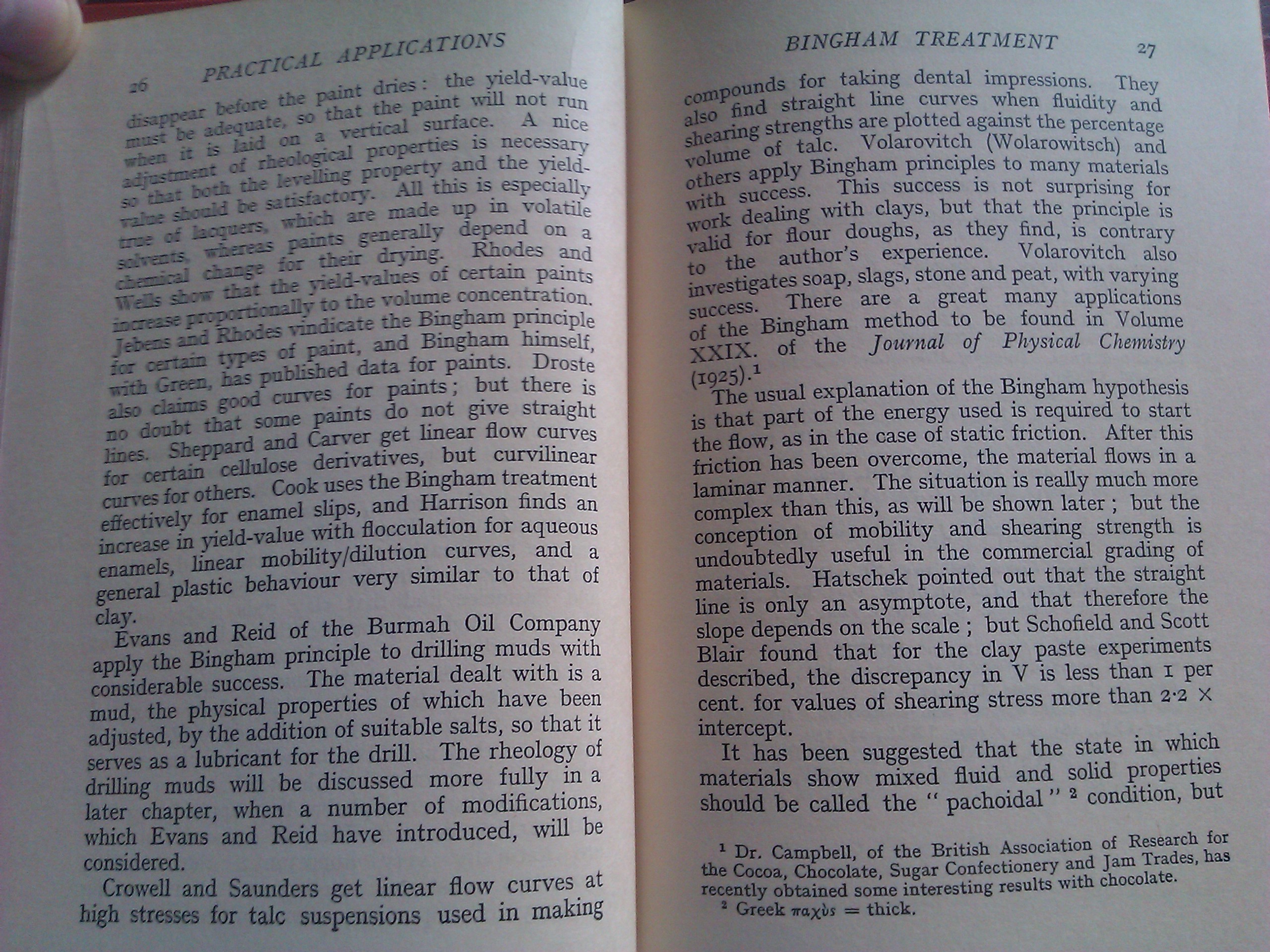str (127)

mm
s& PRACTICAL APPLICATIONS
iłkappar before the paint dries: the yiełd-value mast be Mkąuate, so that the paint will not run wben it is laki on a vertical surface. A mice ł^ństment o£ rheołogical properties is Jgificessary so that both the leyeUmg property and the yield-Tahe sbooid be satisfactary. Ali this is especially trsae ot hcąnaSk which are madę up ift.voIatile
cheamcal chaage for thor drying. Rhodes and WeOs sihosr that the pdd-valnes of oertain paints inccease proportłonaDy to the volnme concentcation. Jdjeas and Rhodes yindicate the Bingham principie for oertain types of paint, and Bingham himself, with Green, has pnblished data for paints. Droste also rłaims good curves for paints; but there is no doubt that senne paints do not give straight lines. Sheppard and Carver get linear flow curves for oertain celłalose derivatives, but curvilinear curves for others. Cook uses the Bingham tfeatment eflfeetively for enamel slips, and Harrison finds aa inerease in yield-value with flocculation for aąueous enamels, Imear mobility/dilution curves, and a generał plastic behaviour very similar tp that of clay.
Evans and Reid of the Burmah Oil Cdmpany apply the Bingham principle to drilling muds Mth considerable success. The materiał dealt withgls ą mud, the physicał properties of which hatfj| heen adjusted, by the addition of suitable salts, so that it serves as a lubricant for the drill.- The rheology of drilling muds will be discussed morę fully in a Iater chapter, when a number of modifi^ations, which Evans and Reid have introduced, will be considered.
Crowell and Saunders get linear flow curves at high stresses for tale suspensions iised in making
compounds for taking dental impressions. They also find straight linę curves when fluidity and shearing strengths are plotted against the percentage volume of tale. Volarovitch (Wolarowitsch) and others apply Bingham principles to many materials with snccess. This success is not surprising for work dealing with clays, but that the principle is valid for flour doughs, as they find, is contrary to the author’s experience. Volarovitch also investigates soap, slags, stone and peat, with varying success. There are a great many applications of the Bingham method to be found in Volume XXIX. of the Journal of Physical Chemistry (1925)1
The usual explanation of the Bingham hypothesis is that part of the energy used is reąuired to start the flow, as in the oase of static friction. After this friction has been OVercome, the materiał flows in a laminar toanner. The situation is really much morę complex than this, as will be shown later; but the conception of^Jptobility and shearing strength is undoubtedly ńseful in the commercial grading of materials. Hatschek pointed out that the straight linę is only!’ an asymptote, and that therefore the slope depends on the scalę; but Schofield and Scott Blair found that for the clay pastę experiments described, the discrepancy in V is less than 1 per cent. for .values of shearing stress morę than 2*2 x intercept.
It has been suggested that the State in which materials show mixed fluid and solid properties should be called the " pachoidaln 8 condition, but
1 Dr. Campbell, of the British Association of Research for the Cocoa, Chocolate, Sugar Confectionery and Jam Trades, has recently obtained some interesting results with chocolate.
| Greek iraxbs — thick.
Wyszukiwarka
Podobne podstrony:
Crochet Borders49 #139STrrCHES & NOTES Notę: Scallops can be btocked so that either the right si
Combining or Separating DDL Statements Before the introduction of online DDL, it was common practice
getstart Codę within head tags is loaded before the rest ofthe document. The script tag denotes the
"^SAFETY PRECAUTIONS* (Always read these instructions before the exercise.) When designing the
Machined microelements have 7 mm height and 0,06 mm wali thickness (Fig. 2 in the middle shows it co
skanowanie0039 (9) The planning stage consists of all those decisions taken before the development a
48082 str (117) 4° ELASTIC DEFORMATIONS i.e., no permanent deformation of the materia] below a certa
Jak robić kolczyki str 1 Basic Tips & Instructions for Beaded Earrings The basie techniques fo
Job Application ick*«»i **t »^c ACt mm ■•< n»lJOB APPLICATION MWł»-a ii • — I-. miaa.YAl MN- OłM-
m337# The lord of St Floret kneels before the Virgin, attended by John the Baptist. In this det
więcej podobnych podstron